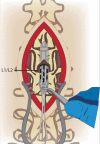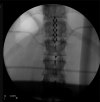Spinal cord epidural stimulation for motor and autonomic function recovery after chronic spinal cord injury: A case series and technical note
- PMID: 37025529
- PMCID: PMC10070319
- DOI: 10.25259/SNI_1074_2022
Spinal cord epidural stimulation for motor and autonomic function recovery after chronic spinal cord injury: A case series and technical note
Abstract
Background: Traumatic spinal cord injury (tSCI) is a debilitating condition, leading to chronic morbidity and mortality. In recent peer-reviewed studies, spinal cord epidural stimulation (scES) enabled voluntary movement and return of over-ground walking in a small number of patients with motor complete SCI. Using the most extensive case series (n = 25) for chronic SCI, the present report describes our motor and cardiovascular and functional outcomes, surgical and training complication rates, quality of life (QOL) improvements, and patient satisfaction results after scES.
Methods: This prospective study occurred at the University of Louisville from 2009 to 2020. scES interventions began 2-3 weeks after surgical implantation of the scES device. Perioperative complications were recorded as well as long-term complications during training and device related events. QOL outcomes and patient satisfaction were evaluated using the impairment domains model and a global patient satisfaction scale, respectively.
Results: Twenty-five patients (80% male, mean age of 30.9 ± 9.4 years) with chronic motor complete tSCI underwent scES using an epidural paddle electrode and internal pulse generator. The interval from SCI to scES implantation was 5.9 ± 3.4 years. Two participants (8%) developed infections, and three additional patients required washouts (12%). All participants achieved voluntary movement after implantation. A total of 17 research participants (85%) reported that the procedure either met (n = 9) or exceeded (n = 8) their expectations, and 100% would undergo the operation again.
Conclusion: scES in this series was safe and achieved numerous benefits on motor and cardiovascular regulation and improved patient-reported QOL in multiple domains, with a high degree of patient satisfaction. The multiple previously unreported benefits beyond improvements in motor function render scES a promising option for improving QOL after motor complete SCI. Further studies may quantify these other benefits and clarify scES's role in SCI patients.
Keywords: Epidural stimulation; Functional recovery; Neuromodulation; Rehabilitation; Spinal cord injury; Spinal cord stimulation; Spinal surgery; Technical note.
Copyright: © 2023 Surgical Neurology International.
Conflict of interest statement
There are no conflicts of interest.
Figures





Similar articles
-
Predictors of volitional motor recovery with epidural stimulation in individuals with chronic spinal cord injury.Brain. 2021 Mar 3;144(2):420-433. doi: 10.1093/brain/awaa423. Brain. 2021. PMID: 33367527
-
Epidural stimulation for cardiovascular function increases lower limb lean mass in individuals with chronic motor complete spinal cord injury.Exp Physiol. 2020 Oct;105(10):1684-1691. doi: 10.1113/EP088876. Epub 2020 Aug 15. Exp Physiol. 2020. PMID: 32749719
-
Normalization of Blood Pressure With Spinal Cord Epidural Stimulation After Severe Spinal Cord Injury.Front Hum Neurosci. 2018 Mar 8;12:83. doi: 10.3389/fnhum.2018.00083. eCollection 2018. Front Hum Neurosci. 2018. PMID: 29568266 Free PMC article.
-
Emergence of Epidural Electrical Stimulation to Facilitate Sensorimotor Network Functionality After Spinal Cord Injury.Neuromodulation. 2019 Apr;22(3):244-252. doi: 10.1111/ner.12938. Epub 2019 Mar 6. Neuromodulation. 2019. PMID: 30840354 Review.
-
A Scoping Review of Epidural Spinal Cord Stimulation for Improving Motor and Voiding Function Following Spinal Cord Injury.Top Spinal Cord Inj Rehabil. 2023 Spring;29(2):12-30. doi: 10.46292/sci22-00061. Epub 2023 May 15. Top Spinal Cord Inj Rehabil. 2023. PMID: 37235192 Free PMC article.
Cited by
-
Obesity in chronic spinal cord injury is associated with poorer body composition and increased risk of cardiometabolic disease.Sci Rep. 2025 Aug 8;15(1):29073. doi: 10.1038/s41598-025-13593-0. Sci Rep. 2025. PMID: 40781458 Free PMC article.
-
Unintentionally intentional: unintended effects of spinal stimulation as a platform for multi-modal neurorehabilitation after spinal cord injury.Bioelectron Med. 2024 May 15;10(1):12. doi: 10.1186/s42234-024-00144-7. Bioelectron Med. 2024. PMID: 38745334 Free PMC article. Review.
-
Predictive modeling of ambulatory outcomes after spinal cord injury using machine learning.Spinal Cord. 2024 Aug;62(8):446-453. doi: 10.1038/s41393-024-01008-2. Epub 2024 Jun 18. Spinal Cord. 2024. PMID: 38890506 Free PMC article.
-
Spinal Cord Stimulation for Functional Restoration in Spinal Cord Injury: A Narrative Review.Cureus. 2025 Feb 6;17(2):e78610. doi: 10.7759/cureus.78610. eCollection 2025 Feb. Cureus. 2025. PMID: 40062017 Free PMC article. Review.
-
Peak Slope Ratio of the Recruitment Curves Compared to Muscle Evoked Potentials to Optimize Standing Configurations with Percutaneous Epidural Stimulation after Spinal Cord Injury.J Clin Med. 2024 Feb 27;13(5):1344. doi: 10.3390/jcm13051344. J Clin Med. 2024. PMID: 38592158 Free PMC article.
References
-
- Angeli CA, Boakye M, Morton RA, Vogt J, Benton K, Chen Y, et al. Recovery of over-ground walking after chronic motor complete spinal cord injury. N Engl J Med. 2018;379:1244–50. - PubMed
LinkOut - more resources
Full Text Sources
Miscellaneous
